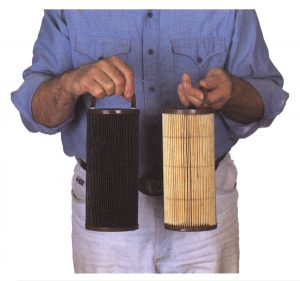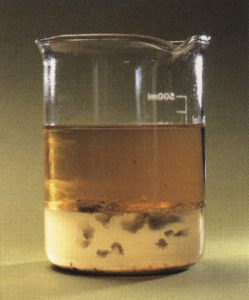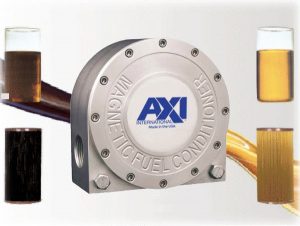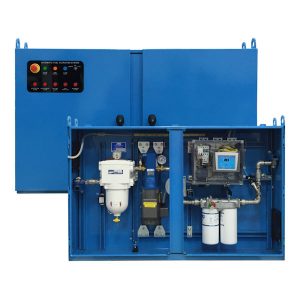Most Diesel Engine Failures
Originate In The Fuel Tank
 Frequent diesel fuel filter changes and the expensive and time consuming task of cleaning diesel fuel tanks have become acceptable periodic maintenance instead of a warning signal for diesel engine failure. Diesel fuel filter elements should last a thousand hours or more, and injectors some 15,000 hours. However, since diesel fuel is inherently unstable, solids begin to form and the accumulating tank sludge will eventually clog your diesel fuel filters, ruin your injectors, and cause diesel engines to smoke (for more on how diesel injectors can be impacted by degraded and contaminated diesel fuel, see the “Diesel Fuel and Injector Failures” discussion on this web site).
Frequent diesel fuel filter changes and the expensive and time consuming task of cleaning diesel fuel tanks have become acceptable periodic maintenance instead of a warning signal for diesel engine failure. Diesel fuel filter elements should last a thousand hours or more, and injectors some 15,000 hours. However, since diesel fuel is inherently unstable, solids begin to form and the accumulating tank sludge will eventually clog your diesel fuel filters, ruin your injectors, and cause diesel engines to smoke (for more on how diesel injectors can be impacted by degraded and contaminated diesel fuel, see the “Diesel Fuel and Injector Failures” discussion on this web site).
The solids that form as the result of the inherent instability of the diesel fuel, and the debris formed in the natural process of fuel degradation, will accumulate in the bottom of your fuel tank. The sludge will form a coating or “bio-film” on the walls and baffles of the fuel tank, plug your fuel filters, adversely impact combustion efficiency, produce dark smoke from the exhaust, form acids that degrade injectors and fuel pumps, and adversely impact performance. Eventually fouled diesel fuel will clog fuel lines and ruin your equipment.
Clogged Fuel Filters
Filter plugging, often the first symptom of a problem, can have several causes and often critical consequences. For example, low temperatures can cause wax crystallization, which can lead to fuel filter plugging (See the Diesel Recovery page for additional information). An example would be using untreated summer diesel fuel in cold weather. Wax or paraffin is part of the diesel fuel and cold temperature crystallize these fuel components. This can be quickly treated by changing to winter grade fuels or by using an additive made to lower the fuel pour-point and improve cold flow properties (See the AFC Series Fuel Additive AFC-805).
But contaminant build up resulting from excessive microbial growth and bio-degradation of diesel fuel can cause fuel filter plugging without regard to temperature. Micro-organisms, bacteria and enzyme activity, fungus, yeast and mold cause diesel fuel degradation and the formation of waste products. The process is similar to milk turning into cottage cheese, a different form of milk. (For a more in-depth look into what microbial and bacteria contamination is, why it is more of a problem now than in the past, and how to deal with it, see the article: “Why Bacteria Hate Magnets“.) Of all the microbial debris and waste products in the diesel fuel tank only about .01% is “bugs”. Even though microbes may cause and accelerate the process of fuel degradation, it should be clear that the waste products clogging your filter are not the microbes but fuel components which have formed solids. These waste products can float in the fuel, being visible when looking into a fuel tank, but also coat the sides, bottom, baffles, and even top of the tank – wherever the fuel touches. Most service personnel are quick to recommend the application of a biocide product to the fuel to address the problem.
The Downside of Biocides

Unfortunately, by the time you realize you have a problem, the effectiveness of biocides are limited. If a heavy bio-film has accumulated on the inside surface of the tank or other fuel system components, the biocide may not be able to penetrate to the organisms living deep within the film. You may see short term relief, but the problem quickly returns as the remaining organisms further reproduce.
Frequently, the application of a biocide aggravates the situation and turns bio-film into solids, creating a real fuel filter nightmare. The introduction of biocide into a fuel tank results in the organic materials turning into a grit that settles to the tank bottom. Then, each time you re-fuel, these materials are stirred up and find their way into your fuel line. As a further complication in the use of biocides, the removal of water from a tank bottom that was treated with biocides must be disposed of appropriately because biocides are toxic.
Although bio-film develops throughout the entire diesel fuel system, most organisms need water to grow, and the bio-growth is usually concentrated at the fuel-water interface in the bottom of the tank. The organism colony feeds from nutrients in the fuel additives. It takes time for the organisms to grow to produce enough acidic byproducts to accelerate tank corrosion or biomass sufficient to plug filters, so a problem may not show itself for months. If you have a problem now, its genesis was likely 6 or more months ago!
Water is the Key
Keeping the water out of the tank is the first and most important step. Water often enters the tank through badly fitting or missing fuel caps. But even with good housekeeping, water still gets into tanks on a regular basis.
Fuel used is replaced by air drawn in through vents. This air often brings moisture with it. This process can be addressed with Desiccant Breathers mounted on the fuel tank vent that captures moisture and prevents the infiltration of the microbial, fungal and particulate contamination.
Without a mechanism to arrest the moisture and contaminants in the vent air flow, this air brings with it these problem-causing issues. Temperature fluctuations cause droplets to condense on the inside walls of fuel tanks and accumulation of water over time provides the habitat for the organisms to reproduce. Also, although less likely, an unlucky end user may be filling up his fuel tank and getting water, organisms and this debris delivered as a part of the process of taking on diesel fuel, for the same price as the diesel fuel. This is less common than many folks think, but it does happen. Consider that the storage tanks that held the fuel before it came to you also pulled air in when the contents were removed, and many of those tanks have accumulated years of debris, bio-film and water.
Condition Your Fuel and Clean Your Fuel System
by Simply Running the Engine
 AXI International (formerly ALGAE-X) provides a variety of Fuel Conditioning and Tank Cleaning Systems that will fit the needs of a Fuel Management Program that may be instituted in any industry, enterprise or by an individual:
AXI International (formerly ALGAE-X) provides a variety of Fuel Conditioning and Tank Cleaning Systems that will fit the needs of a Fuel Management Program that may be instituted in any industry, enterprise or by an individual:
-
The LG-X Series Fuel Conditioner is installed in-line on the fuel line between the fuel tank and the primary filter on any type of diesel powered equipment, whether a truck, construction or farm equipment, generator, marine vessel, fuel dispensing equipment, etc., to condition and polish the fuel as the equipment is operated.
-
The hand-held TK Series Portable Fuel Conditioning and Tank Cleaning System for occasional use on individually owned marine, trucks, motor homes, farm equipment and generators, or for use at a maintenance shop, for tanks up to 1,500 gallons.
-
The MTC Series Mobil Fuel Conditioning and Tank Cleaning Systems, available cart-mounted or pallet-mounted, for enterprises that provide maintenance and repair services on equipment over a wide area, or for enterprises that maintain equipment on job sites, locomotives, mining, emergency power generators, or other fuel tank installations at numerous diverse locations. Models are available capable of treating up to 72,000 gallons in eight hours.
-
STS Series Automated Enclosure Fuel Conditioning and Tank Cleaning Systems are dedicated for use on a marine vessel, storage tank for fixed base primary or backup power generators, or fuel distribution on construction sites, farms, industries, data centers, institutional facilities (hospitals, prisons, universities, water & sewer facilities, first responder locations, etc.). Models are available for treating fuel up to 140,000 gallons in one eight hour period. The FPS Series of Compact Fuel Polishing Systems service smaller installations without including the expense of weather proof enclosures.
AXI Fuel Conditioning and Tank Cleaning Systems provide all users of diesel fuel with protection, performance, fuel economy and lower maintenance costs. Whatever your mission, purpose or enterprise may be, if you depend on diesel fuel to power your equipment, you must have fuel that is as good as it was when it left the refinery. According to Caterpillar, the shelf life of diesel fuel is 12 months, and 6 months for bio-diesel fuel (up to B-20) from when it left the refinery. AXI Fuel Conditioning and Tank Cleaning Systems assure your fuel is in optimal condition at all times, and maintains your diesel fuel in storage in top condition, theoretically forever, for continuing use.
And if your fuel already is showing the symptoms of degradation, all is not lost. Clogged and hazy filters, dark, hazy fuel, floating debris in tanks, sludge build up in tanks, lost power and RPM, excessive exhaust smoke, corroded and pitted fuel injectors, or foul odors coming from your fuel tank can all be reversed without the need to incur the expense of disposing the fuel. Treat the core problem, don’t just treat these symptoms. The AXI Systems perform Fuel Polishing, not just filtration. Your fuel will be returned to that clear and bright condition it had when it left the refinery, and the fuel tank will become a clean and reliable fuel storage asset.
AXI Fuel Conditioning and Tank Cleaning Systems are true Fuel Polishing systems. Don’t be mislead by claims that a system that merely circulates your diesel fuel through a set of filters, augmented by a heavy dose of a biocide fuel additive, will condition your fuel, clean your tank, and solve your problems. Review the Real Story of Bad Diesel Fuel article on this web site to understand what is really happening in your fuel tank. AXI Fuel Conditioning and Tank Cleaning Systems, all of which incorporate the AXI patented Fuel Conditioner as the core component of each System, are designed and built in the USA to reverse these problems with degraded and contaminated diesel fuel. To understand the significance of the Fuel Conditioner and how it contributes to the most critical part of fuel polishing, review the web page on this site that explains the technology behind this amazing device.

TK Series Portable Fuel Polishing & Tank Cleaning System
You may need to start by determining if you really have a diesel fuel related problem. If you have been treating your diesel fuel with a biocide, but still find you have the symptoms of fuel deterioration mentioned above, you have looked far enough. Commonly used chemical testing procedures will show a negative presence of bacterial and fungal growth as a result of the biocides. Concluding that the fuel is in acceptable condition and the fuel system is healthy because of the lack of active bacterial or fungal growth would be a misinterpretation of test results. This does not mean that the diesel fuel is in acceptable condition. Use of biocides do not solve the problem, but they do present new and different problems to diesel fuel maintenance.
If you have not used biocides in the past, the first step to determine if you have a microbial contamination problem may be to use Liqui-Cult fuel test kits as a way to monitor fuel tanks for microbial activity. Liqui-Cult accurately detects and quantifies bacterial and fungal growth in fuel and other fluids. This microbial growth requires water to exist and resides in the fuel-water interface where it feeds off the additives and nutrients in the fuel. However, if you can see that you have the above mentioned symptoms, you can bypass this step, but Liqui-Cult testing periodically is an important component of a preventative maintenance and Fuel Management Program.

Degraded Fuel Shortens Filter Life and Hurts Engine Performance
The next step is to determine how much water is in the bottom of the fuel tank and plan for it’s removal. The extent of water contamination can be determined using Kolor-Kut Water Finding Paste. Place a line of the paste on a rod and insert it into the tank extending to the bottom of the tank. The paste on the rod that comes into contact with water changes color, providing an indication of how much water is in the bottom of the tank.
A small siphon can be used to determine the condition (visual signs of growth) of the water. You can also use a length of 1/2 inch PVC or more flexible PEX pipe like a soda straw to extract water from the tank bottom. With your thumb over the end of the pipe, insert the pipe to the bottom of the tank. When the pipe end is resting on the bottom, remove your thumb allowing the bottom tank material to rise up inside the pipe. Replace your thumb over the end, remove the pipe, and empty the contents of the pipe into a clear plastic 2-liter soda drink bottle (place the bottle inside a 5-gallon bucket to catch any spillage). Repeat the process to fill the bottle and then allow it to sit overnight.
Visually inspect the contents of the soda bottle after it has settled and separated. If the fuel is clear and bright with no water separation on the bottom or dirt, sludge or clumps of debris in the bottom, then your problem is not in your fuel. But if these signs are present, read on.
If a large amount of water is present, the water should be pumped out. The TK Series Portable Tank Cleaning System or, for a larger tank or multi-tank installation, the MTC Series Mobil Tank Cleaning Systems, mounted on a cart or pallet, allows you to pump water off the bottom of your fuel tank for proper disposal.
Since every tank configuration is unique, and sometimes the access to a tank is only the fuel filler neck, it may be necessary for you to customize a soft copper pipe or other semi-flexible pipe product, such as PEX, to snake into the bottom of the tank. Pump the water from the tank bottom into a bucket or drum for proper disposal. After all the free water that can be removed has been removed, small residual amounts of water can be removed using the AFC Series 705 Diesel Fuel Catalyst, Stabilizer and Tank Cleaning Additive. The AFC 705 additive contains a surfactant that will emulsify the residual water into the fuel. During the circulation phase (see below) the emulsified water will be filtered out of the diesel fuel in the fuel polishing process. For post-2007 engines requiring additives that are Tier-4 compliant, the AFC Series 710 Diesel Fuel Catalyst, Stabilizer and Tank Cleaning Additive will clean the tank and stabilize the fuel, but does not have the surfactant component. AFC-710 has a chemical affinity to the hydrocarbons in your diesel fuel, helping your engine tap into your fuel’s full potential by burning it more completely. While it is doing so, it’s also cleaning your fuel system from the fuel tank, to your injectors, to your combustion chamber, and through to your exhaust.
The addition of AXI AFC-705 or 710 Diesel Fuel Catalyst will stabilize the fuel and enhance and accelerate the tank cleaning process by breaking down, dispersing, and dissolving existing tank sludge and slime, stabilize and restore fuel quality, decontaminate compartments of the tank that are out of reach of the suction line, and eliminate costly contract tank cleaning and fuel disposal fees. Treatment with the LG-X Series Fuel Conditioner completes the process of returning the diesel fuel to a clear, bright, efficient, and usable fuel.
Using a Water Block Filter Element in the TK Series Portable System, the MTC Series cart or pallet mounted system, or an appropriately sized STS Series or FPS Series Automatic Fuel Cleaning and Tank Management Systems will remove the emulsified water from the fuel while also filtering particulates.

MTC X Cart Mounted Mobile Fuel Polishing & Tank Cleaning System
The fuel circulation process is handled in two ways. Any time an AXI Fuel Conditioning and Tank Cleaning System is used, the fuel tank should be full and be treated with a dose of AFC Series 705 or 710. The first time a tank is treated, especially when it has a known contamination problem, the dose of AFC-705 should be a double dose (1 oz. additive to 20 gallons of diesel fuel) and the fuel should be circulated five times. A periodic preventative maintenance treatment would include a regular dose of AFC-705 or AFC-710 (1 oz. additive to 40 gallons of diesel fuel), and the fuel should be circulated three times.
As an example, a contaminated tank has a capacity of 500 gallons. You have a TK-240 XT Portable Tank Cleaning System that has a circulation rate of 240 gallons per hour. To circulate the fuel five times, you would circulate a total of 2,500 gallons of fuel. At 240 gallons per hour, you would need to operate the circulation system for 10.5 hours. You do not necessarily need to perform the treatment for a continuous time. The 10.5 hour run time can be performed over two or three contiguous days.
How often you would perform a preventative treatment depends largely on regional climate conditions. More humid locations may require a treatment every 4 to 6 months. More arid areas may only require treatments once each year.
As an ongoing preventative maintenance procedure, water in the fuel tank can be dealt with by using the Water Eliminator. The Water Eliminator can be kept in the tank and monitored at each refueling to determine the presence of water. Additional diesel fuel filtration and water removal can be achieved with the installation of a supplemental Fuel Filter/Water Separator.
To further reduce the potential of moisture entering into your equipment or fuel storage tank, the addition of a desiccant breather to the tank vent will significantly reduce the moisture in the air drawn into the fuel tank as fuel is consumed.
The most important feature of all AXI Fuel Treatment and Tank Cleaning Systems is the simple fact that, when a fuel tank is determined to be badly contaminated and cleaning is necessary, you no longer need to incur the cost and hassle of:
-
paying for a repair technician (or employee) to remove the existing contaminated fuel from your fuel tank
-
paying the cost of properly disposing of the contaminated fuel
-
paying for the removal of the fuel tank from mobile equipment
-
paying for the time required to clean, in some fashion, the inside of the tank with high pressure water or steam
-
paying for the time for the repair technician (or employee) to reinstall the equipment tank
-
paying for a new tank of fuel
Many of our customers have quickly learned that the investment in an AXI Fuel Conditioner and Tank Cleaning System quickly pays for itself, and more often than not, more than offsets the ongoing expense of accepting the low performance of contaminated fuel, and the high cost of shortened engine filter and fuel system component life that has become considered by many as a necessary and acceptable practice.
Please enjoy browsing the Diesel-Fuels.com web site, and do not miss the numerous Articles available on this site about specific applications and industries that depend on stored fuel, as well as the Guides to Maintaining Diesel Fuel that provide printable papers for reading and distribution.Contact Pecuniary, Inc., and solve your diesel fuel problems once-and-for-all!
Symptoms…
- Clogged and Slimy Filters
- Dark, Hazy Fuel
- Floating Debris in Tanks
- Sludge Build-up in Tanks
- Loss of Power and RPM
- Excessive Exhaust Smoke
- Corroded, Pitted Fuel Injectors
- Foul Odor Emitting from Fuel Tank
